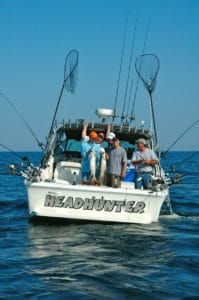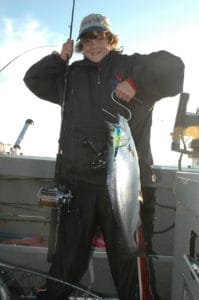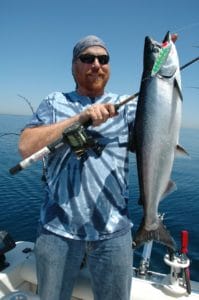by Dave Mull
If it’s true that one man’s trash is another man’s treasure, it’s hard to figure why many Great Lakes salmon and trout trollers refer to lead-core and copper lines as “junk.”
Sure, they’re super long and can be a pain to reel in, but the so-called junk lines work. They often catch fish when lines on downriggers and divers turn ice cold. In fact, they are usually the top rig when the sun climbs high, attracting strikes all day long.
That reason alone is enough to put them into your arsenal. Let’s look at how to fish with them effectively and tangle free. Well, more or less tangle free.
Junk lines are segments of lead-core line or braided copper line that, basically, are a long sinker that takes lures down closer to deep fish. Such segments are usually at least 30 feet long, and can be as much as 600 feet long. Lead-core and copper both have fans, and some anglers use both types. The main difference is copper lines sink farther and faster than lead core.
For hard-fighting salmon, anglers put backing underneath the weighted lines on the reel—almost always baitcasting reels with large line capacities—to allow these fish to run and tire. Backing is usually 30- to 50-pound braided line or 20- to 30-pound monofilament. Anglers must also tie on a leader—usually as short as 8 feet or as long as 60 feet depending on personal taste—between the sinking lines and the lure.
Most modern salmon trollers put these lines out on planer boards, either the ski-and-tether system that uses large “skis” and clips that hold the fishing line to the tether line, or, more commonly, “on-line boards” that clip to the backing.

Copper or lead-core lines combine with planer boards and allow anglers to spread lines to the side and at various depths.
Boards accomplish three main things that help put more fish in the boat. First, a board takes a line out to the side of the boat into undisturbed water—the boat can actually spook fish out to the side and into the path of a lure.
Second, the boards add strike-triggering action to the lures behind them. As the boat makes slight turns, the boards on the inside of the turn slow down, making the weighted line and lure sink, while the boards on the other side speed up, making those lures rise in the water column. This vertical movement of the lure makes it act more like an injured baitfish when it slows down and sinks; it acts like a fleeing baitfish when it speeds up and rises.
Third, unlike a lead sinker that pendulums back toward a fish that hits the lure, copper and lead core provide a direct connection to the planer board, resulting in surer hookups.
Weighted lines on boards also allow you to fish multiple lures on each side of the boat, covering different depths with different colors and sizes of lures. Salmon boats commonly troll two or three per side—I’ve put as many as five per side, more to see if I could do it than to see if I could catch more fish. I achieved the feat, with a flotilla of 10 Church Walleye Boards flying in formation around the boat, but I figured the spread of lures was at the point of diminishing returns: The chance of a tangle outweighed the possibility the spread would catch more fish.
To avoid tangles between board lines, the shorter, shallower lines are set first and go to the outside of the spread.
Each line set to the inside is longer and goes deeper. Most fish that get hooked tend to swing behind the moving boat, those hooked son the shallower outside lines rarely dive down and tangle lines inside of them. More commonly, tangles happen when fish hooked on inside lines swim up and to the side into lines outside of them. One way to help avert such a tangle is to let the outside boards out farther when an inside line hooks up.
Resetting outside lines and getting them past inside lines (impossible to do on a ski-and-tether planer board system) takes patience and timing. You must let all the weighted line into the water, attach the boards to the backing and then let the board out behind the boat occasionally thumbing your baitcast reel to keep the line from sinking all the way to the bottom. When you’ve let enough line out that the board will plane into formation, engage the reel and immediately put the rod in its rod holder. Usually the board will pick up enough speed to lift the line over the inside lines.
Even the best, most experienced Great Lakes trollers occasionally get a tangle, some of them so bad that the lead core or copper does end up as junk. Maybe that’s how they got tagged with that moniker. Whatever, they rarely get called “junk” on my boat. That’s because they catch more than their share of fish.
The Union Sportsmen’s Alliance website is designed to provide valuable articles about hunting, fishing and conservation for members of AFL-CIO affiliated labor unions and all sportsmen and sportswomen who appreciate hunting and fishing and want to preserve our outdoor heritage for future generations. If you would like your own story and experience from the outdoors to be considered for our website, please email us at USAmembers@unionsportsmen.org.





